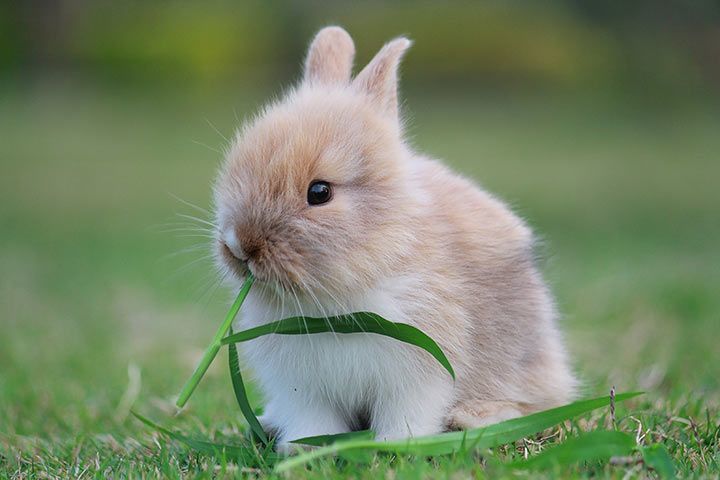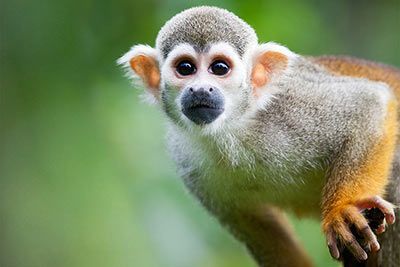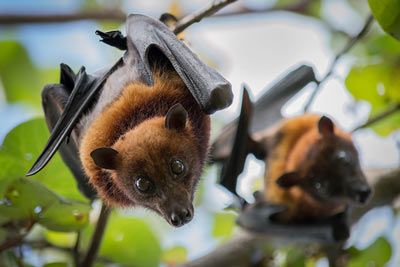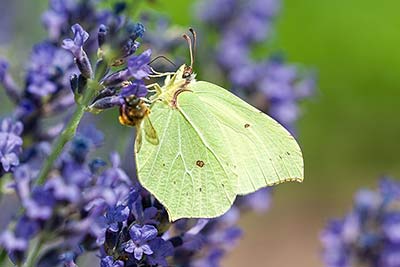Rabbit
Rabbit Facts
| Size | 7.8-27.5 in (20-70 cm) (dwarf/giant) |
| Speed | Unknown |
| Weight | 2.4-26 lb (1.1-12 kg) (dwarf/giant) |
| Lifespan | 6-10 years |
| Food | Grass, hay, herbs, green fodder |
| Predators | - |
| Habitat | Pet |
| Order | Lagomorpha |
| Family | Leporidae |
| Scientific name | Oryctolagus cuniculus forma domestica |
| Characteristics | Long ears, hops around |
Main Characteristics
Domestic rabbits are a cultivated form of the European rabbit and very popular as pets. They are very sociable and like to dig, eat and hide. Even if you frequently can see them gnawing away at things: They are no rodents, but are classified as lagomorphs. There are about 88 species, such as the Arctic hare, the European rabbit, the black-tailed jackrabbit, and the cottontail rabbit.

Anatomy and Appearance
Rabbits do not need to turn their heads to see what’s behind them. They have a 360 degree view and are farsighted, which means, that they perceive objects at large distances very clearly. This allows them to detect approaching enemies very quickly.
The Biggest
According to the Guinness Book of World Records, the giant rabbit Ralph is the world’s heaviest rabbit. It weighs 55.1 pounds (25 kg). Its owner has to spend about 60 euro every week to provide enough food for Ralph.
The Smallest
The smallest species among pet rabbits is the Netherland dwarf rabbit. It weighs between 2.4 and 2.9 pounds (1.1 to 1.35 kg).
The Oldest
According to the Guinness Book of World Records, the world’s oldest rabbit reached an age of 17 years and two weeks. The Jersey Wooly was born in 1997 and was called “Do”.
The Longest Ears
Nobody needed to pull the English lop rabbit Nipper’s Geronimo by the ears. It had unbelievably long ears: 31.1 pounds (79 cm) long and 7.2 inches (18.4 cm) wide. The ears of our admin at animalfunfacts.net are 2.5 inches (6.5 cm) long and 1.3 inches (3.5 cm) wide. How big is your ear?
Teeth
Like many rodents, rabbits have teeth that never stop growing. However, they never grow too long, as their teeth wear down as they eat.

Behavior
When predators are around, rabbits warn each other. They whimper and thump the ground with their hind legs.
Rabbits as Pets
Hamsters, chinchillas and mice sleep during daytime. The rabbit is awake and active during the day. This makes it very popular as a pet, but people sometimes misinterpret its behavior. Owners often feel sad and frustrated, because their rabbits are aggressive. But this is just a sign that they are unhappy because they are not kept appropriately.
How Do You Keep Them?
Rabbits can be bored, too. For instance, if they are kept alone, because they need the company of their fellow species. They also need physical exercise and don’t like it at all to spend all day in a tiny cage. If they feel good they purr. If they are extremely happy, they run about the place wildly, jump into the air and kick out with their hind legs.

Reproduction
Rabbits are born blind after a gestation period of about 30 days. One litter usually comprises four to six babies. Or even more. According to the Guinness Book, a New Zealand rabbit has had the largest number of babies so far: 24 of them!
Fun Facts
Kaninhop
Most people do not know that rabbits are capable of learning tricks. Similar to dogs, they can run through tunnels or cross bridges in agility sports. In the Swedish sport "Kaninhop", they jump over hurdles. There are even European Championships. The exercise is good for them and also stimulates them mentally. A rabbit from Denmark achieved the highest jump in 1997 and reached a height of 39.1 inches (99.5 cm).
The Rabbit Is Related To:
- Cottontail Rabbit
- Domestic Rabbit
- Pika
Animals in the Same Biome:
- Badger
- Brimstone Butterfly
- Eagle
- Hedgehog
- Magpie
- Microbat
- Red Fox
- Lynx
- Pigeon
- Raven
- Weasel
- Wolf
- Wolverine




















